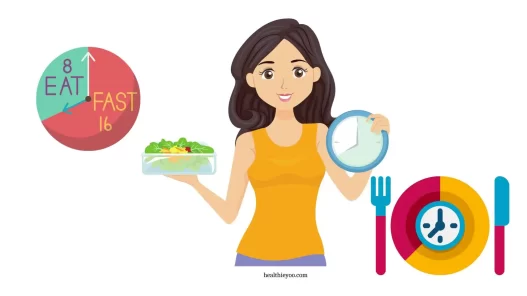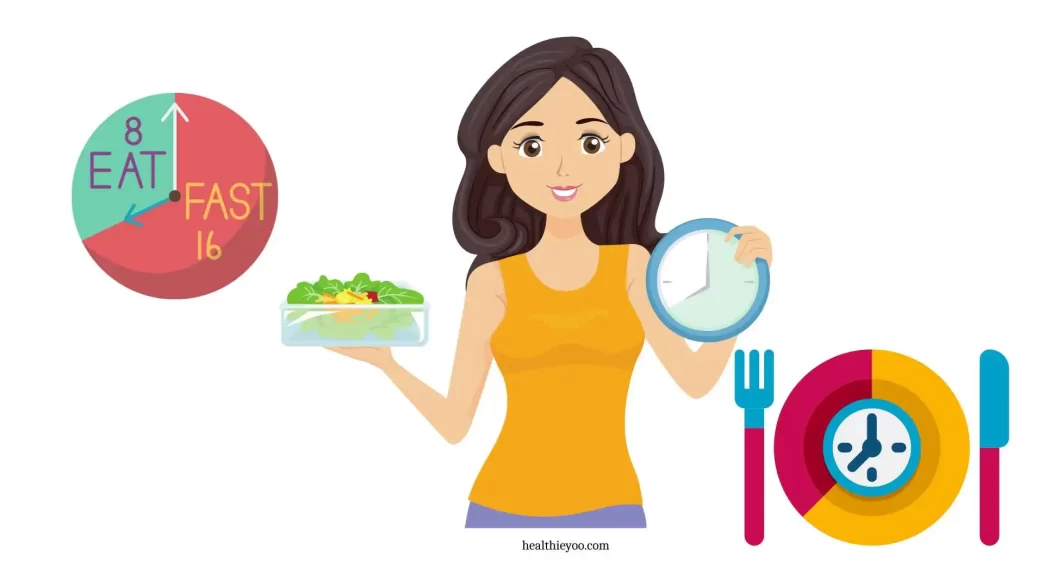Intermittent Fasting health benefits, types (TRE, 16:8, 5:2, alternate day fasting) for weight loss, and practical tips for meal planning.
A diet plan of intermittent fasting consists of alternating fasting and eating times. It emphasizes when to consume meals rather than what to eat. Intermittent fasting seeks to provide defined time frames for eating and not eating, which could have several health advantages. So, let us learn about the intermittent fasting health benefits, different types of intermittent fasting, and suggestions for including it into your daily schedule.
An intermittent fasting diet plan will comprise a shift of fasting and eating times. It plays more importance on the timing of meals rather than the content of the meals. Intermittent fasting describes likely periods within which one is supposed to eat and abstain from eating, periods that could be associated with numerous health benefits. Let us thus, look intermittent fasting healthy benefits plus types of intermittent fasting and how to put it in your daily life.
Intermittent Fasting Types
The following are different types of intermittent fasting:
Time-Restricted Eating
Timerestricted eating (TRE) is widely used intermittent fasting strategy. TRE restrict your daily eating window to a particular number of hours, usually 8 to 10 hours. This implies you eat only during that set time and fast for the rest of the day.
Alternate Day Fasting
Another method is alternate-day fasting, in which you shift between a day of normal eating and a day of strict calorie restriction or fasting. On fasting days, the total calories consumed is limited to a small fraction of the usual intake or even zero calories.
Modified Fasting
Some people prefer to change their fasting days by eating less calories, usually about 25% of their normal intake. This strategy lets one benefit from fasting while still some food is consumed.
Intermittent Fasting Health Benefits
The various health benefits of intermittent fasting are:
Weight Loss
Intermittent fasting may help throttle the weight gain by imposing an eating window or reducing caloric intake on the days when people fast. It may help preserve also hormones related to appetite regulation. Several randomised clinical trials too supported its effects on weight loss in obese adults.
Improve Insulin Sensitivity
Insulin sensitivity, which can help control blood sugar levels and lower the risk of type 2 diabetes, has been proven to be improved by intermittent fasting.
Enhance Cellular Repair
Fasting periods start cellular repair mechanisms including autophagy, in which broken cells are recycled. This can help improve general cellular health.
Benefits the Heart
Certain research point to intermittent fasting improving indicators of heart health including inflammatory response, blood pressure, and cholesterol levels.
Improve Cognitive Functions
Research has started to show that intermittent fasting may help improve cognitive function, as well as reduce the risk of neurodegenerative diseases, so helping the brain.
Intermittent fasting looks very promising but in reality it might not work for each and every individual. People should consult a medical provider before starting any fasting plan, those with certain medical issues, pregnant or nursing mothers, and also those having a history of disordered eating.
Keep in mind that general health depends on eating a balanced and nutritious diet. One should give intermittent fasting careful thought and customised instruction to verify it runs with personal aims and requirements.
10 Tips for incorporating Intermittent Fasting into your routine
Choose the right method
Since intermittent fasting may be approached differently, it is vital to choose a technique that fits your taste and lifestyle. Many individuals find time restricted eating (TRE), which restricts the amount of food you consume every day, to be a popular and sensible choice.
Start gradually
Slowly introducing yourself into intermittent fasting can be very helpful if you are new to it. Start a few days or weeks by incrementally extending the fasting window. Begin with a 12hour fasting window, for instance, and progressively lengthen it to 16 or 14 hours.
Find your optimal eating window
You may have to play around with different eating windows to see what suits you best. Some would like it early, some late. Listen to your body and choose a time that aligns with your natural hunger cues and your ‘usual’ schedule.
Stay hydrated
Remembering to hydrate regularly during the eating window is equally important. Fasting does not mean that you have to deprive yourself of getting hydrated. Water is the best choice, although herbal tea or other non-caloric drinks could be considered to ensure the body does not get dehydrated and reduce hunger.
Energy in from nutrient-dense foods
As you wake up and begin to break your fast, the food should mostly be nutrient-dense to acclimate your body to some fuel. That means you must eat well-rounded meals of lean proteins, whole grains, fruits and vegetables, and healthy fats to get enough nutrient.
Portion Size Considerations
Intermittent fasting is not calorie counting, but portion sizes are still something you should be mindful of. Eat the right portions and use portion control, allow your body to tell you when you are full.
Listen to your body
Really listen to notice how your body responds to intermittent fasting. Fasting window too long or possibly not for you, but if you feel ill or just horribly hungry, that can be a sign. Change course as necessary and if in doubt a healthcare professional.
Keep the same timetable
When you can, try to stick to an organised fasting and feeding rhythm. Consistency will help your body adapt better during the times you are fasting consistently and it can be more manageable as part of your daily routine.
Patience and Flexibility
Fasting does not happen over night, you’ve also got to wait time-wise on results with IF. Patience is key, allow your body to adjust. Also keep them in mind, staying flexible to how you may have to handle social gatherings and travel, etc.
Ask a Pro
It is also recommended that you speak with a healthcare professional or registered dietitian especially if you have other pre-existing health conditions and/or concerns before beginning intermittent fasting. They can offer personal recommendations and make sure it fits what you need individually.
Intermittent fasting is not for everyone and what works for one person does not work for another. Listen to your body, listen to what it says and KNOW that by listening your overall health will be set. Interfering with your body clock is not a diet, it is an eating pattern where the cycles of eating and fasting are alternated.
Popular Approaches to Intermittent Fasting that one can consider
16:8 Method
The method involves fasting for 16 hours each day and limiting your eating time to 8 hours. That would be basically skipping breakfast and eating your first meal at noon, then stopping at dinner time around 8 pm or so.
5:2 Diet
On the 5:2 diet, you eat normally for five days of the week and then restrict calorie intake to around 500-600 calories for women or 600-800 for men on two non-consecutive days. The fasting days should be a week apart, not consecutive.
Alternate Day Fasting
It basically consists of a fast day (when you decrease your calories intake or have no consumption at all) and an eating day in which you eat as much as you want.
Eat-Stop-Eat
With that means, a 24 hours fasting is done every 1 to 2 weeks. Let us say for instance that you decide to not eat food after dinner in one day and then instead decide to eat dinner the following day.
Warrior Diet
This involves a day or two per week of fasting (eating just one meal a day). The rest of the day you are allowed to eat back smalls amounts of fruits and veggies along with protein rich foods.
Just be aware intermittent fasting can be a powerful tool for weight management and all other health benefits, but it also does not allow you to write-off overall nutrition and indulging with healthy food during your eating times. Include whole grains, lean protein, fruits and veggies, and good fat to manage your nutrition successfully.
Also, keep in mind that not all individuals may benefit from intermittent fasting at all and especially those with health conditions or are pregnant or breastfeeding. If you’re curious about making any kind of changes to what and when you eat, then the best thing is always to talk with a professional such as a registered dietitian or healthcare provider.
Tips for Meal Planning While on Intermittent Fasting
Create a Meal Plan To Accomplish Your Nutritional Needs.
Limit highly processed foods, those that are calorie dense but nutrition void.
Beware of calorie-dense healthy foods (walnuts, oils) if you are trying to drop some weight; even in moderation!
Try using smaller plate or bowls to make a visual portion control feel like less.
Foods to Include
- High-protein foods to preserve muscle and keep you satisfied.
- Foods rich in fiber such as vegetables, fruits and legumes as well whole grains reliefs hunger and aids gastrointestinal health.
- Monounsaturated fats such as olive oil, avocados, nuts — these will help to satisfy and keep you feeling healthy.
- Do not forget hydration — lots of water, herbal teas and other zero calories liquids.
- Non-nutritive fermented food such as yogurt, kefir, and sauerkraut contributes to gut health.
Portion Sizes
Vegetables
They should contain a rainbow of colors greens, reds, oranges)-and types (leafy greens, cruciferous, root vegetables). Such as 1 to 2 cups of leafy greens raw or 1/2 cup cooked.
Fruits
With fresh, frozen and dried fruits without added sugars are healthy options. As a rule of thumb, one piece or 1/2 cup of fresh / frozen/ dried fruit.
Proteins
Include lean meats, poultry, fish, eggs, dairy, beans, legumes, and tofu. A portion size for meat is about the size of a deck of cards (3-4 ounces), while for plant-based proteins, a portion might be 1/2 cup of legumes.
Include protein source meats/poultry/fish, eggs, milk & dairy beans, legumes, and tofu. A serving in meat is like 3-4 ounces and for a plant protein, it is around ½ cup beans.
Whole Grains
Incorporate whole grains like brown rice, quinoa, barley, oats, and whole-grain breads. A portion is usually 1/2 cup cooked grains or 1 slice of whole-grain bread.
Healthy Fats
Include avocados, nuts, seeds and olive oil. As fats are calorie dense, portion size could be one Tablespoon of oil to 2 Tbsp nuts or seeds.
Conclusion
In short, intermittent fasting has been an effective lifestyle solution for everyone looking to improve health and lose weight. Methods like the 16/8 protocol, 5:2 diet, Eat-Stop-Eat, and alternate-day fasting, all provide flexibility in case an individual would like to select one way of eating that fits their lifestyle more. Successfully, intermittent fasting is about discovering what works for you, your way of life and your goals. Your health and well-being, over just losing weight — it needs to be that we put overall health above losing a number on the scale. Further, people can consider the advice of a healthcare provider or a dietitian for personalized recommendations.
Ultimately, intermittent fasting is a tool in a larger toolbox of health. Not a magic bullet but the mantra is eat healthy and always moving for a successful outcome. Different people may respond differently to a particular dietary strategy and it is essential that they talk with their healthcare professional. Even if you are pulled towards fasting for weight loss, metabolic or other health gains, doing so in a mindful way will help set you up for a successful and long-lasting lifestyle change.

Sneha Manesh, PharmD., is a clinical research intern at Kamineni hospital, Hyderabad, Telangana. She is proficient in various aspects of pharmacy practice such as medication therapy management, pharmaceutical care, and patient counseling.












